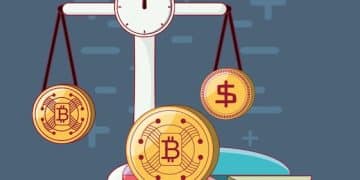Decentralized lending strategies: unlocking new opportunities

Decentralized lending strategies enable direct peer-to-peer transactions over blockchain, offering benefits like lower costs, greater access, and increased transparency while facing challenges such as market volatility and smart contract risks.
Decentralized lending strategies are changing the way we think about borrowing and lending money. Have you ever wondered how these innovations could impact your financial decisions? Let’s dive in and explore the possibilities.
Understanding decentralized lending
Decentralized lending is transforming the financial landscape, bringing new possibilities for borrowers and lenders alike. This method removes traditional intermediaries, like banks, and leverages blockchain technology to connect individuals directly.
What is Decentralized Lending?
At its core, decentralized lending allows users to lend and borrow assets without a central authority. Instead, smart contracts on blockchain networks automate the process, ensuring that transactions are secure and efficient. This framework creates a transparent system where users can see terms and conditions clearly.
Benefits of Decentralized Lending
There are several reasons why this method is gaining popularity:
- Lower fees compared to traditional lending systems.
- Access to funds for those who may struggle to secure loans through conventional methods.
- Greater privacy, as personal information is often less exposed.
- Global reach, enabling users from different regions to participate.
The growth of decentralized lending is also fueled by the rise of decentralized finance (DeFi). DeFi platforms offer users various financial services beyond just borrowing and lending, including staking and yield farming, which are often integrated into lending platforms. This interconnectedness creates more opportunities for users to maximize their assets.
Another intriguing aspect is the potential for liquidity pools. In these pools, individuals can contribute funds, allowing others to borrow against them. This model promotes collaboration within the community and increases overall liquidity, creating a dynamic lending ecosystem.
How to Get Started
If you’re interested in participating in decentralized lending, here’s how to begin:
- Choose a reputable platform that supports decentralized lending.
- Create a digital wallet to store your assets securely.
- Understand the risks involved, as prices can be volatile.
- Start small by lending or borrowing a modest amount to grasp the mechanics.
As you explore decentralized lending, keep an open mind and remember that while there are many advantages, it’s crucial to stay informed about potential risks. Engaging with community resources can help you navigate the evolving landscape.
Benefits of decentralized lending strategies
The benefits of decentralized lending strategies are numerous and can significantly enhance how individuals interact with financial services. This approach offers innovative solutions to traditional lending challenges.
Lower Transaction Costs
One of the main advantages of decentralized lending is the reduction in costs associated with borrowing and lending. By eliminating intermediaries, users save on fees that typically arise in traditional systems. This means that both lenders and borrowers can enjoy better rates and higher returns.
Increased Accessibility
Decentralized lending creates opportunities for individuals who may not have access to conventional banking systems. This includes borrowers in underbanked regions or those with limited credit history. By allowing direct peer-to-peer transactions, everyone can participate in the financing process.
- Users can access funds quickly and efficiently.
- There are fewer restrictions on qualifications.
- Innovative platforms cater to diverse needs and preferences.
An essential aspect of decentralized lending is the enhanced transparency it offers. Borrowers and lenders can see the terms of the agreement clearly and understand how the process operates. This openness fosters trust among users, which is vital in any financial transaction.
Another benefit is the potential for higher returns for lenders. By participating in lending pools, lenders can fund multiple loans and earn interest from various borrowers. This diversification can lead to increased profitability compared to traditional lending, where returns are often limited.
Flexibility in Terms
Decentralized lending platforms usually offer flexible terms tailored to meet individual borrower and lender needs. Users can negotiate loan amounts, interest rates, and payment schedules directly, leading to more personalized agreements. This flexibility can help borrowers find suitable options and improve their financial management.
Engaging with decentralized lending not only promotes financial freedom but also encourages a sense of community. Users can support each other and build relationships through mutual benefit, ultimately creating a more inclusive financial ecosystem.
Key players in the decentralized lending space

Understanding the key players in the decentralized lending space is crucial for anyone looking to navigate this innovative financial ecosystem. These players include individuals, platforms, and protocols that facilitate lending and borrowing.
Decentralized Lending Platforms
Several platforms have emerged as leaders in decentralized lending, each offering unique services. Some of the most notable include:
- Aave: A popular DeFi platform that allows users to lend and borrow cryptocurrencies with variable and stable interest rates.
- Compound: This platform enables users to earn interest on their crypto holdings by lending them to others.
- MakerDAO: A decentralized lending platform that allows users to collateralize assets to generate stablecoins.
These platforms utilize smart contracts to automate lending processes, ensuring security and transparency. By connecting lenders and borrowers directly, they eliminate the need for traditional banks and their associated fees.
Governance Token Holders
Another significant group in decentralized lending are governance token holders. These individuals have a say in the decision-making processes of various platforms. By holding tokens, they can vote on important issues, such as changes to protocol rules or the allocation of funds. This governance model empowers users and fosters community involvement.
Moreover, investors in these tokens can earn rewards for their participation, creating a cycle of engagement and commitment within the ecosystem. This system enhances accountability and aligns the interests of platform users.
Many of the successful decentralized lending platforms also collaborate with other projects and protocols, broadening their reach and enhancing functionality. For instance, partnerships with decentralized exchanges can provide liquidity, while integrations with insurance protocols enhance user security.
Decentralized lending is also supported by developers and innovators within the cryptocurrency community. These individuals work on enhancing the technology surrounding lending platforms, creating better user experiences and improving security measures. This technological evolution factors significantly into the overall success and growth of decentralized lending.
How to implement decentralized lending
Implementing decentralized lending is a straightforward process that can open up new financial opportunities for both borrowers and lenders. The journey begins with understanding the basic steps involved in utilizing these innovative platforms.
Step 1: Select a Reliable Platform
Your first step is to choose a trustworthy decentralized lending platform. Popular choices include Aave, Compound, and MakerDAO. These platforms have solid reputations and a wide range of features that can meet various needs.
Step 2: Set Up a Digital Wallet
To use these platforms, you’ll need a digital wallet that supports cryptocurrencies. Some popular wallets include MetaMask and Trust Wallet. Make sure to backup your wallet information securely to prevent any loss.
- Download your chosen wallet application.
- Create a new wallet account and store your recovery phrase safely.
- Transfer some cryptocurrency into your wallet to start lending or borrowing.
After setting up your wallet, you can link it to the chosen lending platform. This connection is essential because it allows you to manage your assets and participate in lending activities.
Step 3: Understand Borrowing and Lending Terms
Before diving in, familiarize yourself with the terms of borrowing and lending on your preferred platform. Different platforms have varying interest rates, collateral requirements, and repayment options. Read the guidelines carefully to avoid any surprises.
Decentralized lending often requires collateral to secure loans. This collateral usually comes in the form of cryptocurrency. Understanding the collateralization process is vital for both lenders and borrowers.
Step 4: Start Lending or Borrowing
Once everything is set up, you can begin to engage in lending or borrowing. If you’re lending, you’ll supply your cryptocurrency to the platform, making it available for others to borrow. You will earn interest based on the amount and duration of the loan.
If you’re borrowing, you’ll select the amount you need and provide collateral as required. Keep in mind the interest rates and repayment timelines to ensure you can meet your obligations.
Throughout the process, stay updated on market trends and platform changes. Participating in community forums and discussions can also enhance your understanding of decentralized lending.
Challenges in decentralized lending solutions
Decentralized lending solutions present exciting opportunities, but they also come with challenges that users must navigate. Understanding these challenges can help individuals make better decisions when engaging with decentralized finance.
Market Volatility
One major challenge is market volatility. The value of cryptocurrencies can fluctuate significantly within short periods. This volatility affects both lenders and borrowers, especially when collateral is involved. If the value of the collateral decreases, borrowers may face liquidation, which means their assets could be sold off to cover loan amounts.
Smart Contract Risks
Another concern is the risks associated with smart contracts. These self-executing contracts are fundamental to decentralized platforms. However, if there are any bugs or vulnerabilities in the code, it can lead to severe financial losses. Users must ensure they use platforms with reputable audits and strong security measures.
- Look for platforms that provide transparency about their security audits.
- Stay informed about recent vulnerabilities in the decentralized finance space.
- Participate in community discussions about best security practices.
Additionally, the lack of regulatory oversight can be both a challenge and an advantage. While decentralization allows for more freedom, it also leaves users unprotected against fraud and scams. Without government regulations, users should conduct thorough research before investing in any platform.
Limited User Awareness
Limited user awareness is another significant hurdle. Many people may not understand how decentralized lending works or the risks involved. This knowledge gap can lead to poor financial decisions, making education and community engagement crucial for new participants.
Many platforms are actively working to improve user experiences by providing resources and tools for better understanding. Having access to guides, tutorials, and community forums can help users feel more confident and informed.
FAQ – Frequently Asked Questions about Decentralized Lending
What are the main benefits of decentralized lending?
Decentralized lending offers lower transaction costs, increased accessibility, higher returns for lenders, and flexible loan terms.
How does market volatility affect decentralized lending?
Market volatility can impact the value of collateral, potentially leading to liquidation if the asset’s value drops significantly.
What risks are associated with smart contracts in decentralized lending?
Smart contracts can have bugs or vulnerabilities, which might lead to financial losses if exploited by malicious actors.
How can I educate myself about decentralized lending?
You can educate yourself by reading guides, joining community forums, and participating in discussions to gain insights from experienced users.





